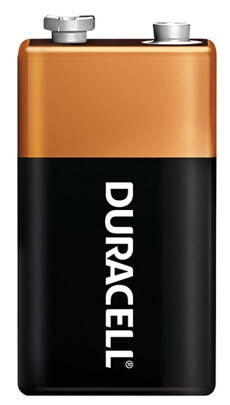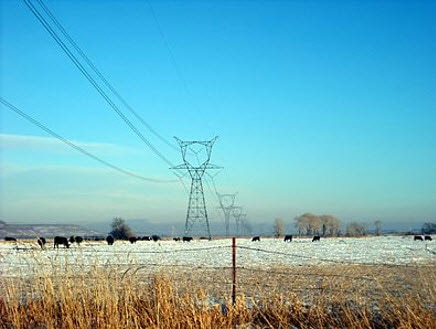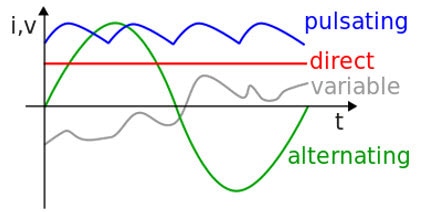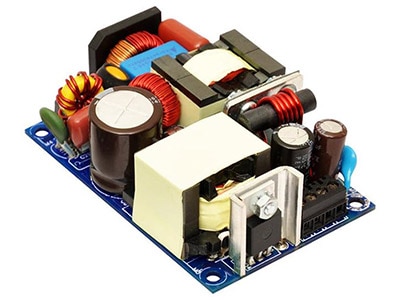AC/DC: Not Just a Band!
2024-01-24 | By Antonio Velasco
Let's talk about AC (Alternating Current) and DC (Direct Current). This blog will serve to be a reference point for some of my later blogs (for example, AC-DC conversion) and to be a nice little rundown on the two types of current. It'll also clear up some misconceptions and hopefully make it all a little bit clearer. So, let's get down to brass tacks!
Direct Current
Direct current is the typical type of current you may be using for your electrical projects. Put simply, it is the flow of electrons in one direction. You may notice that you'll have a negative (or ground) side and a positive side. Electrons, by nature, are negative and originate from the negative terminal going toward the positive, providing a constant flow of electricity in one direction.
Let's put this into the context of a rushing river that provides water to some lakes. If we were to compare this to DC, we'd just imagine the river running in one direction.
DC current typically comes from batteries, like the 9V or AA/AAA ones you may have at home, or solar cells. It is worth noting that most of the electrical grids across the word utilize AC, which is why whenever you get a solar system, you need to get an inverter as well (which will convert the DC to AC current, a concept that I'll cover in a later blog.)

You'll typically want to use DC current for devices that need a simple constant supply of power, like most electrical circuits.
Alternating Current
Alright, now let's get into the real bread and butter: AC current. I'll admit, it took me a good second to totally grasp it when I first heard of it too. Let's dive straight in.

Alternating current is the type of current that's used in electrical grids and everyday outlets. To put it simply, the flow of electrons alternates between two directions. Think of it as reversing the polarity over and over again, having electricity flow one way and then the opposite right after.
Let's put this into the context of a rushing river that provides water to some lakes, like the DC current example, this time with AC current. If I have a river that runs from left to right, in an AC current example, it will rush left to right for a few seconds, then right to left for another few, and then repeat over and over again. This doesn't affect the lakes though, as water is still being applied to it.
Comparing the Two

The most evident difference comes in this graph, which displays an alternating and direct current line, where the x-axis is time. The alternating current will of course have the direction sometimes be positive and sometimes be negative, oscillating between the two. Direct current will always be constant in one direction, thus the straight line. There is also pulsating and variable current, but they are not typically used.
Although the rushing river example made explaining the two types of current a little easier, it doesn't help when comparing DC and AC current--mainly because water doesn't share the electromagnetic properties that electricity does (and thus gives AC an edge over DC). The biggest difference between the two, other than the direction of current, is the efficiency in certain usages. AC current is typically used in electrical grids as it can be easily transformed with magnetic fields, whereas DC voltage needs more complex circuitry and a number of components, making it not only less efficient but also much more complicated and more expensive. The reason why the ability to transform electricity is important is because in a big grid, the main source supplies a large amount of power which then needs to be broken down by the individual customers, or houses/businesses. Think of it like getting water from a big pool, and AC current is a much more efficient way of getting said water than DC current since with the former, you'll lose less water moving it and it's also much cheaper to add in.
It's worth noting that, across the world, the two are used in conjunction with each other given that they have multiple usages. For example, your phone actually requires DC current as opposed to AC current. This is the reason why phone chargers require a "brick," as this component will change the AC current into DC current for your phone.

I also mentioned how solar cells will produce DC current but need to be converted into AC current for usage. All of this comes into play as the two are used for different reasons and shouldn't necessarily be compared directly. You'll typically see AC current for longer-distance power transmission due to its greater efficiency and ability to change its voltage easily. DC current is used in smaller components that may not necessarily need a lot of electricity and for components that need to have a constant flow of energy. I'll talk more about converters in a later blog, though.

Wrap-Up
The concept of AC current can be mind-boggling. One can only imagine what Nikola Tesla saw when he first explored AC current. In fact, there was a whole battle between Thomas Edison (who supported DC) and Nikola Tesla (who supported AC) as forms of electricity.

Overall, though, both types of current are very important for our society as, with a "bigger" pool, it is important to have an easily malleable current, and with components that require a stable current, it is important to receive such.

Have questions or comments? Continue the conversation on TechForum, DigiKey's online community and technical resource.
Visit TechForum












 中国
中国